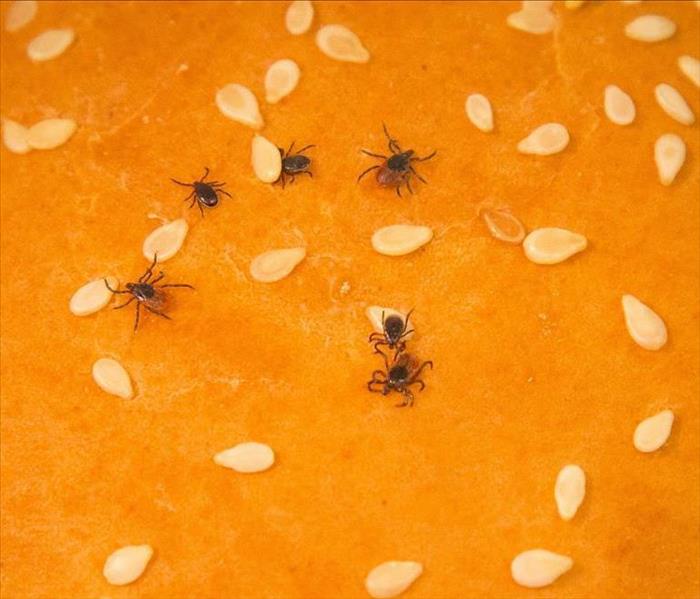Ticks are back!
5/11/2022 (Permalink)
 Photo of male and female adult blacklegged ticks on a sesame seed bun to demonstrate relative size. Photo credit: CDC
Photo of male and female adult blacklegged ticks on a sesame seed bun to demonstrate relative size. Photo credit: CDC
The warm weather is returning and the sun is shining, that means more time spent outdoors. After being cooped up for the long Winter months, it's refreshing to be able to get back out there!
We are not the only thing to settle down for the Winter, only to reemerge when the melting and thawing are over.
Ticks!
This is the time of year when ticks rear their ugly little heads and we need to be ready for them!
According to the CDC tick exposure can occur year-round, but ticks are most active during warmer months (April-September).
Knowing which type of tick is common in your local region can help you to determine what steps are best at preventing tick bites.
According to the CDC Geographical Map the most common ticks to inhabit the Northeast are listed below.
American Dog and Brown Dog tick:
- Widely distributed east of the Rocky Mountains. Also occurs in limited areas on the Pacific Coast.
- Transmits: Tularemia and Rocky Mountain spotted fever.
- The highest risk of being bitten occurs during spring and summer. Dog ticks are sometimes called wood ticks. Adult females are most likely to bite humans.
Blacklegged tick (AKA Deer Tick):
- Widely distributed across the eastern United States.
- Transmits: Borrelia burgdorferi and B. mayonii (which cause Lyme disease), Anaplasma phagocytophilum (anaplasmosis), B. miyamotoi disease (a form of relapsing fever), Ehrlichia muris eauclairensis (ehrlichiosis), Babesia microti (babesiosis), and Powassan virus (Powassan virus disease).
- The greatest risk of being bitten exists in the spring, summer, and fall. However, adults may be out searching for a host any time winter temperatures are above freezing. Stages most likely to bite humans are nymphs and adult females.
So, how can we best avoid these guys while still enjoying the great outdoors?
We should first know where to expect ticks.
Ticks live in grassy, brushy, or wooded areas, or even on animals. Spending time outside walking your dog, camping, gardening, or hunting could bring you in close contact with ticks. Many people get ticks in their own yard or neighborhood.
Treat clothing and gear with products containing 0.5% permethrin. Permethrin can be used to treat boots, clothing and camping gear and remain protective through several washings.
*If you are an avid camper or hiker you can buy permethrin-treated clothing and gear.
Use a chemical repellent with DEET, permethrin or picaridin.
Wear light-colored protective clothing.
Tuck pant legs into socks.
Avoid tick-infested areas if possible and stick to the middle of trails when walking them.
Make sure to check yourself and your pets as soon as you come in. It's important to check your clothing as well because ticks may be carried into the house on them and any gear that you or your pet may be wearing.
Any ticks that are found should be removed.
You can tumble dry clothes in a dryer on high heat for 10 minutes to kill ticks on dry clothing after you come indoors.
If the clothes require washing first, hot water is recommended. Cold and medium temperature water won't kill ticks.
The CDC recommends showering within 2 hours of coming inside because it has shown to reduce the risk of getting Lyme disease as well as other tick born diseases. It will also help to wash away any ticks that haven't latched on yet and gives you the opportunity to do an all over body check.
When doing a body check on yourself or your children, pay attention to these areas:
- Under the arms
- In and around the ears
- Inside belly button
- Back of the knees
- In and around the hair
- Between the legs
- Around the waist
Let's look forward to a fun and active Summer free of ticks!!






 24/7 Emergency Service
24/7 Emergency Service